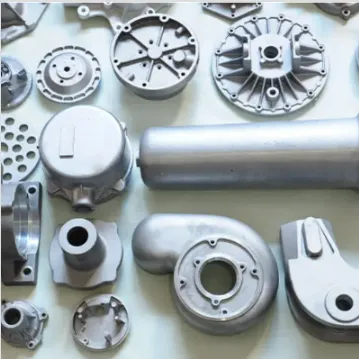Mobile:+86-311-808-126-83
E-mail:info@ydcastings.com
The Fundamentals and Processes of Aluminum Metal Casting
Aluminum metal casting is a manufacturing process that involves pouring molten aluminum into a mold to create a desired shape or component. This technique is widely utilized across various industries due to aluminum's lightweight, corrosion resistance, and excellent thermal conductivity. From automotive parts to aerospace components, aluminum casting plays a crucial role in modern manufacturing. This article delves into the fundamentals and processes of moulage de métal en aluminium, highlighting its importance and applications.

The Importance of Aluminum Metal Casting
Aluminum is a versatile material chosen for casting due to its numerous advantages. Firstly, its low density makes it ideal for applications where weight reduction is critical, such as in the automotive and aerospace industries. Additionally, aluminum's corrosion resistance ensures that cast components retain their integrity over time, reducing maintenance costs and extending product lifespan. Furthermore, aluminum's high thermal conductivity makes it suitable for applications that require efficient heat transfer, like heat exchangers in automotive cooling systems.
Types of Aluminum Metal Casting Processes
Several methods exist for casting aluminum, each suited to different types of applications and production volumes. The most common processes include:
Sand Casting: This is the most traditional and versatile casting method. It involves using a mold made of sand mixed with a bonding agent. The mold is crafted to the shape of the desired casting and then filled with molten aluminum. Once cooled, the sand mold is broken away to reveal the cast component. Sand casting is suitable for large and complex shapes.
Die Casting: In die casting, molten aluminum is injected under high pressure into a steel or hardened tool steel mold. This process yields high-precision castings with excellent surface finish and dimensional accuracy. Die casting is ideal for producing large quantities of small to medium-sized parts.
Investment Casting: Also known as lost-wax casting, this process begins with creating a wax model of the desired component. The wax model is then coated with a ceramic slurry and fired to burn out the wax, leaving a hollow ceramic shell. Molten aluminum is poured into this shell, and once cooled, the ceramic is removed to reveal the casting. Investment casting is used for intricate designs and small to medium-sized parts.
Gravity Casting: As the name implies, gravity casting relies on the force of gravity to fill the mold with molten aluminum. This method is often used for producing large components with thick walls where pressure is not required to achieve the desired shape.
Design Considerations for Aluminum Metal Casting
When designing parts for moulage de métal en aluminium, several factors must be considered to ensure successful production and optimal performance. These include:
Wall Thickness: Uniform wall thickness helps avoid hot spots during cooling, reducing the risk of porosity and cracks.
Draft Angles: Adding draft angles to the mold allows for easier ejection of the casting from the mold, preventing damage to the part.
Gating and Risering: Proper design of gating systems (channels for molten metal to enter the mold) and risers (reservoirs to feed molten metal to the mold cavity) ensures complete filling and minimizes defects.
Thermal Expansion: Aluminum expands significantly when heated, so designers must account for this to avoid dimensional inaccuracies.
Post-Processing and Finishing
Once cast, aluminum components often require post-processing to achieve the final desired appearance and functionality. This may include:
Shot Peening: A process that uses compressed air to propel small, spherical media at high velocity onto the surface of the casting, improving surface hardness and fatigue strength.
Machining: To achieve precise dimensions and features, castings may undergo machining operations such as turning, milling, and drilling.
Surface Treatment: Coatings, such as paint, powder coating, or anodizing, can enhance corrosion resistance, aesthetics, and durability.
Applications of Aluminum Metal Casting
Aluminum metal casting finds applications across numerous industries, including:
Automotive: Engine blocks, transmission housings, wheel hubs, and other critical components benefit from aluminum's lightweight and corrosion resistance.
Aerospace: Lightweight aluminum castings are crucial for aircraft structures, engine components, and fuel systems.
Electronics: Housings for electronic devices, heat sinks, and other components leverage aluminum's thermal conductivity.
Médical: Aluminum metal casting are used in surgical instruments, prosthetics, and imaging equipment due to their biocompatibility and corrosion resistance.
Aluminum metal casting is a fundamental manufacturing process that enables the production of lightweight, durable, and complex components across various industries.
As a specially in metal castings , our business scope is very broad .We have valve body , steam valve , impeller , volute casing , pump body , end cap , automobile water pump , motor housings , pump casing , motor casing , fan housing , cast iron connector , aluminum metal casting , stainless investment casting and pièces moulées en métal and so on . The aluminum metal casting price in our company are reasonable . If you are interesting in our product welcome to contact us !
-
Materials Used in Manufacturing Cap End Pipe FittingsNouvellesNov.24,2025
-
Material Properties of CF8M CastingNouvellesNov.24,2025
-
How to Inspect Pump Cap Ends for DamageNouvellesNov.21,2025
-
Backward Curved Impeller – Efficient Airflow Solutions for Industry | YD CastingsNouvellesNov.21,2025
-
Automobile Water Pump - Efficient, Quiet, Durable & ElectricNouvellesNov.21,2025
-
Impeller for Pumps – High-Efficiency, Durable, OEM-ReadyNouvellesNov.21,2025











